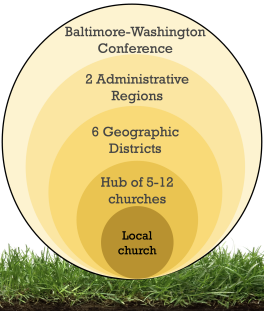Restructuring for Vital Change
 When considering how to restructure the Baltimore-Washington Conference for more vitality, more than a thousand clergy and laity made it clear. They were seeking a configuration that created increased relationships, collaboration, innovation, discipleship, and connection.
When considering how to restructure the Baltimore-Washington Conference for more vitality, more than a thousand clergy and laity made it clear. They were seeking a configuration that created increased relationships, collaboration, innovation, discipleship, and connection.
The new plan is intended to offer just that.
While the details of the plan are nuanced; in a nutshell:
- Five to 12 local churches are grouped in a Collaborative Hub in a shared, geographically-based mission field. Each hub will have a designated Connecting Church, to facilitate collaborative work and vitality.
- Moving from eight districts to six for missional effectiveness. Each Hub will be assigned to a district where the congregations share common challenges/environments.
- This creates opportunities to network across perceived boundaries and learn from one another in diverse, and yet similar, contexts.
- The hubs and districts are organized into two administrative regions.
As part of this process, at the May 2024 session of Annual Conference, members voted to reduce the number of districts from eight to six.
Restructuring Timeline
The timeline for implementation begins in June 2024 and ends July 1, 2025.
June 2024:
- June 1, 2024: Members to AC are given restructuring materials to take back to their churches.
- June 15, 2024: A survey is sent out to the pastor plus nine key leaders of all churches to facilitate the formation of congregational groups/hubs. A separate survey is sent to clergy only regarding their covenant group status.
July 2024:
- July 12, 2024: Assess any impact on the restructuring plan of General or Jurisdictional Conferences.
January 2025:
- All leaders share the bishop's video with their followers, stakeholders, and peers; commit to personal and community revitalization; and invite everyone to respond to the calls to action
- All leaders share wave 1 materials and resources and invite everyone to respond to the calls to action
February 2025:
- February 11: Town Hall on Restructuring and Revitalization
- Streamline processes and centralized admin pool created
- Post new full-time positions, including three Vitality Strategists (formerly known as Resource Coordinators)
- Invitations go out to Connecting Church SPRC’s and Pastors without information about which churches will be in their hub
March 2025:
- March 6: Special e-connection featuring the second wave of resources for local churches
- All leaders share wave 2 materials and resources and invite everyone to respond to the calls to action
- 40-Day Season of Prayer for Vital Change
- Discipleship Council completes pilot for an annual evaluation tool for ministry leaders that measures a congregation’s missional impact and leads toward increased church vitality.
- As available, provide a draft of district and region information to the Rules Committee, Discipleship Council and Nominations Committee so that the leadership report, policies, and procedures can be updated
April 2025:
- All leaders share wave 3 materials and resources and invite everyone to respond to the calls to action
- After Easter: Collaborative Hubs, Districts, and Regions are published
- Discipleship Council shares the annual congregational evaluation tool
May 2025:
- May 3: Pre-Con
- May 13-15 Annual Conference: Collaborative Hub and District Kick-Off
June 2025:
- June 7: New Appointment Workshops
July 1, 2025:
- New collaborative hubs, districts, centralized admin regions, clergy groups, and accountability systems are in place with resource pools.
2026-27 Ministry Year:
- A vitality management system for holistic accountability is developed after receiving feedback on the first year of hubs and other aspects designed to support the vitality of local churches.
Several members of the Restructuring Task Force explain different aspects of the restructuring proposal:
Living a Vision
Bishop Easterling lays out the vision for Restructuring
Overview
Rev. Bill Brown gives an overview of the main points of the restructuring proposal
Hubs Create Crucible of Ministry
Rev. Dawn Hand explains how the collaborative hubs in the new proposal will increase ministry vitality
Two Regions – A Ministry of Administration
Rev. Dr. Daryl Williams explains how the two administrative districts will help churches streamline administrative tasks to allow more energy for creative ministry
Every aspect of the restructuring plan is interwoven with the values of the BWC and its vision of creating vitality mission and ministry in every local church. Resources to help local churches share with their congregation the vision and potential of Restructuring for Vital Change are available.
